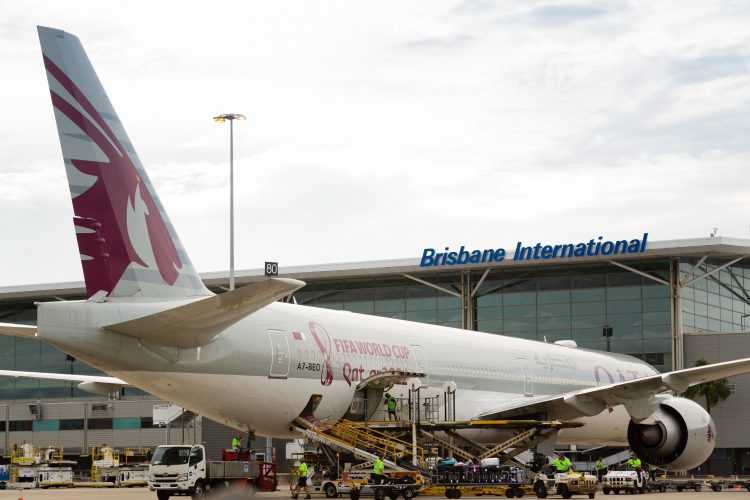Brisbane International Airport’s post-pandemic route development strategy
- Like
- Digg
- Del
- Tumblr
- VKontakte
- Buffer
- Love This
- Odnoklassniki
- Meneame
- Blogger
- Amazon
- Yahoo Mail
- Gmail
- AOL
- Newsvine
- HackerNews
- Evernote
- MySpace
- Mail.ru
- Viadeo
- Line
- Comments
- Yummly
- SMS
- Viber
- Telegram
- Subscribe
- Skype
- Facebook Messenger
- Kakao
- LiveJournal
- Yammer
- Edgar
- Fintel
- Mix
- Instapaper
- Copy Link
Posted: 6 November 2023 | Anthony Cicuttini | No comments yet
Anthony Cicuttini, Senior Vice President and Head of Aviation Development, Brisbane Airport Corporation, writes exclusively for International Airport Review on how Brisbane airport has navigated post-pandemic challenges to develop and enhance global air connectivity.


Credit: BNE
Brisbane International Airport (BNE), Australia’s third largest airport by passenger volumes, has seen a remarkable recovery since the depths of COVID-19. Passenger volumes hit record lows in April and May of 2020 and it took another two years until the market began to trend upwards on a sustained basis. This of course came after several false starts across both domestic and international segments on the back of border openings and closures. Since that time, BNE’s traffic has seen steady increases and as of June 2022-June 2023, the domestic and international markets recovered 91% and 64% respectively over the 12 months ending June 2019.
Similar to other airports throughout Australia, international markets with large leisure and visiting friends and relatives (VFR) exposure saw the fastest recoveries. New Zealand, Indonesia (primarily Bali), and Fiji were some of the markets that stood out; Fiji in fact is now exceeding 2019 levels of traffic.
The initial shape of the recovery was largely defined by border openings, both domestic and international. As the recovery matured, this has shifted. Airline fleet and crew availability are now the dominant factors to where and when capacity is added, issues that appear not to be unique to BNE.
Route development in a post COVID-19 world
BNE’s post-COVID route development strategy has been focused on two primary areas:
- Attracting back incumbent capacity and;
- Exploring new opportunities
Having a two-pronged approach has allowed BNE to customise engagement strategies and overall priorities to recover in the most efficient way possible. The difference in these strategies largely rests with leveraging the maturity of the relationships with airlines and other partners. An airline that previously operated to BNE would already have a solid understanding of the market, key demographics, fare levels, and other attributes that would convince them of the underlying opportunity. Consequently, engagement has focused on maintaining relationships, presenting data focused on changes in the market and overall structure, and customising incentive offers towards a market re-entry.
The air transport market changed considerably during the pandemic and with this change came a new opportunity for BNE. In October of 2022, the airport saw United Airlines commence services from the San Francisco – Brisbane route at a three time per week frequency. This was the first time an American-based airline operated scheduled services to the airport.
There have been other success stories as well. Vietjet started services on the Ho Chi Minh City – Brisbane route, connecting Queensland for the first time ever to Vietnam – a truly historic moment. Jetstar, though they were operating at BNE already, announced a significant expansion of services to destinations such as Tokyo Narita, Osaka, Incheon, as well as expanded capacity to Auckland and Bali. Once in full operation by February, 2024, these new services will promote BNE from Jetstar’s sixth largest international port to it’s second. These new opportunities required a different approach compared to securing back previous services. Data analysis was focused on underlying market fundamentals and the education of the destination. Marketing activities also took this into account with destination awareness and education being a key pillar. The incentive offered differs in structure as well to help support the new route during the initial start-up phase.


Credit: BNE
Partnership is key
Across both of these pillars is a common theme, and that is collaboration. In fact, this is one of Brisbane Airport’s key values (care, communication, and courage are the others in case you were wondering. Together they make up our “4 C’s”). BNE would not have been able to achieve what it has to date without the support of our key stakeholders. Early in the recovery, the Aviation Attraction Investment Fund (AAIF) was established by the Queensland Government in conjunction with four key airport partners throughout the state. The programme has supported almost all returning and new routes at the airport with allocations of marketing funds and performance incentives. Our tourism and trade partnerships with Tourism and Events Queensland, Trade and Invest Queensland, and the Brisbane Economic Development Agency have been instrumental in either providing funding, resources, expertise, or a combination thereof to support the recovery. It has been a tremendous team effort and a good take away for the reader; route development cannot be done alone and working with key partners, including airlines, is critical.
What the future holds for BNE
BNE’s aviation business development team is divided into two work streams: aviation development and aviation marketing and partnerships. Quite simply the former chases the seats and the latter fills them. Both teams work extremely close with one another and together, they develop a seven-pillar strategy that aims to unlock BNE’s current strengths in the market while setting the scene for future growth. BNE’s geographic position is central to a number of these pillars. In several key markets, BNE has a distance advantage over other Australian airports in connecting key traffic flows, namely from Asia into Oceania and the domestic market. BNE is looking to capitalise on this further in the future to increase the airport’s attractiveness as a hub. Additionally, BNE’s proximity to SE Asia and key pacific markets opens up growth opportunities as the A220 and A321XLR’s come into airline fleets that are not available to other airports.
Building towards the Brisbane Olympics in 2032, expect to see more great things from the BNE team and its partners. The destination has something tremendous to offer to the world and more airlines are realising the opportunity here. To say we’re excited is an understatement.


Anthony Cicuttini, SVP and Head of Aviation Development
Anthony Cicuttini is the SVP and Head of Aviation Development at Brisbane Airport Corporation where he leads a team of talented aviation business development managers and analysts to attract airline capacity to the airport. Prior to this, he was Managing Director of Redwater Consulting Group, a specialist aviation strategy consultancy focusing on forecasting and economics.
Originally from Canada, Anthony relocated to Australia permanently in 2011 having worked overseas prior in Dubai and Malaysia in support of terminal development and airport planning projects. He holds an Advanced Diploma and a Masters Degree in Aviation Management from Georgian College and Griffith University respectively. Through his consulting roles, he has completed projects in over in 20 countries.

















